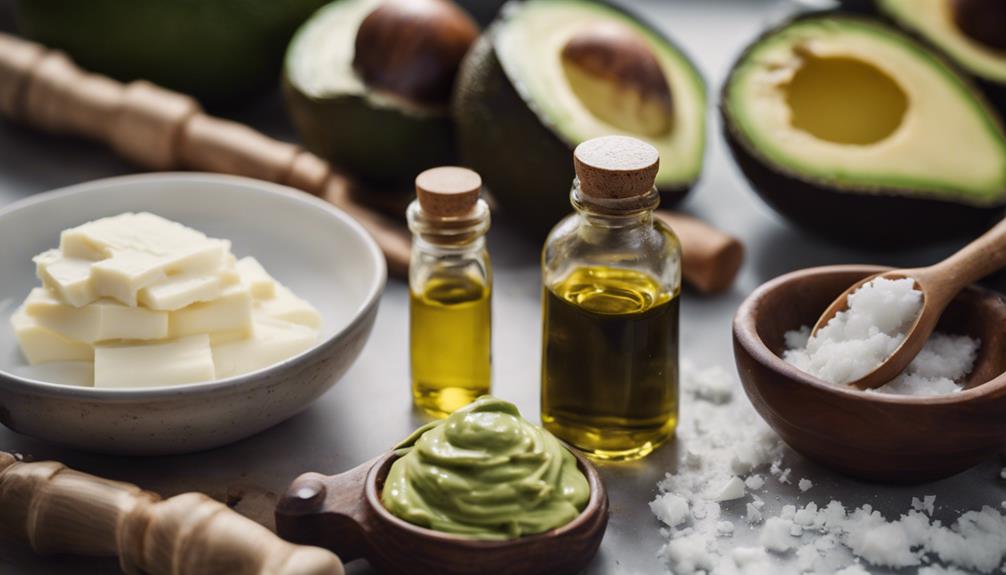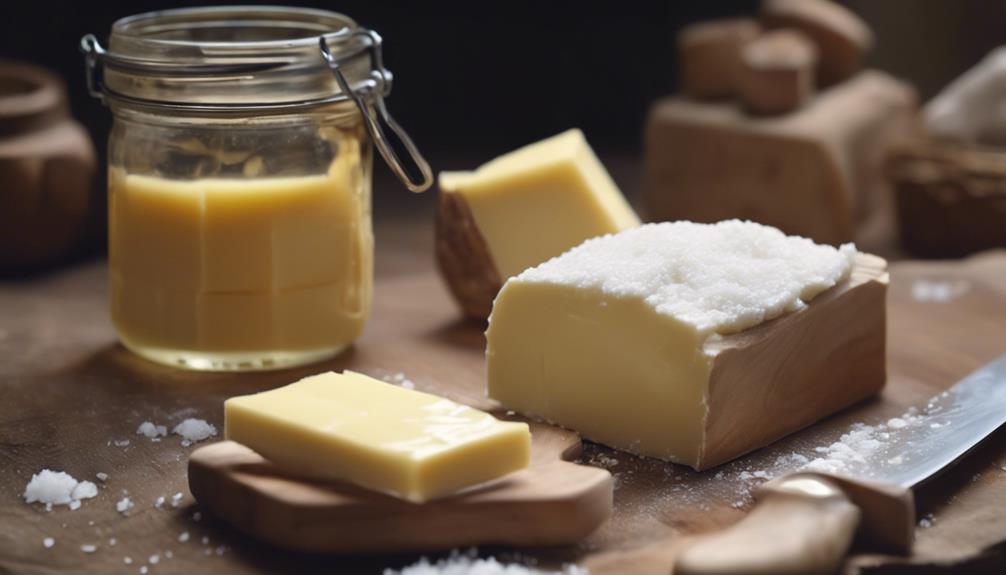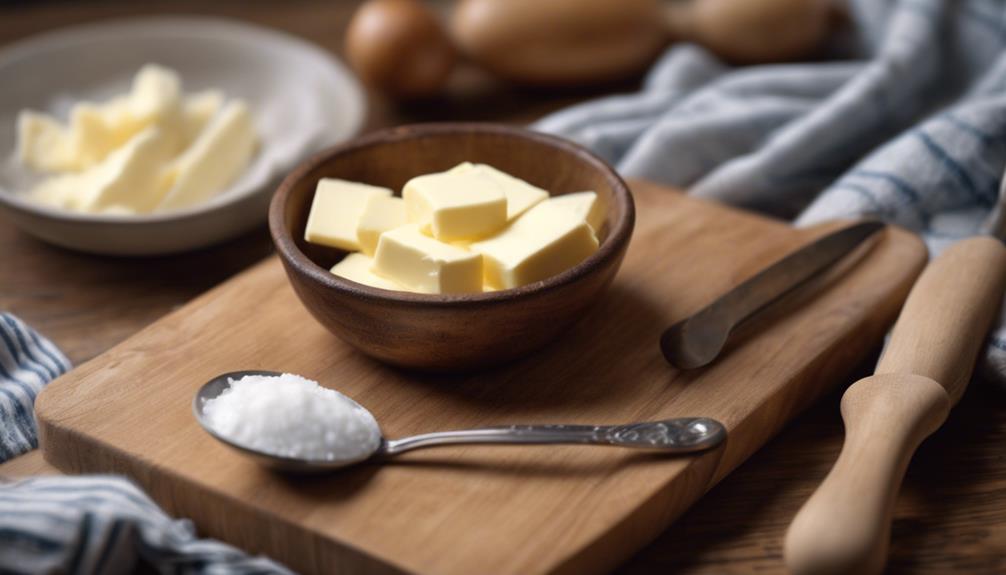Transform your mornings with spreadable joy by making homemade spreadable butter. Combine softened butter with liquid oil for that perfect smooth texture. Whip them together until creamy to personalize the salt content and flavor. Try olive, avocado, or canola oil for unique tastes. Use it easily on toast, enhancing meals with superior quality and healthier fats. Invest in a few key ingredients, mix them up, and voila! Elevate your meals effortlessly. Enjoy the convenience of homemade spreadable butter while saving money and reducing plastic waste. Make your mornings delightful with this simple kitchen hack!
Key Takeaways
- Soften butter at room temperature for easy blending.
- Mix softened butter with liquid oil for spreadability.
- Experiment with oil ratios for desired consistency.
- Whip mixture until smooth and creamy.
- Store homemade spreadable butter in the fridge to set.
Benefits of Homemade Spreadable Butter
Homemade spreadable butter offers several advantages over store-bought options. To begin with, it's a cost-effective alternative, saving you money in the long run.
The superior taste and quality of homemade spreadable butter surpass store-bought margarine, enhancing the flavor of your meals.
In addition, homemade spreadable butter is a healthier choice as it contains lower levels of saturated fats compared to regular butter. You have the freedom to customize the salt content in homemade spreadable butter, catering to your preferences and dietary needs.
Furthermore, the convenience of homemade spreadable butter allows for easy use straight from the fridge, saving you time in the kitchen.
Making Spreadable Butter

To make spreadable butter, start by combining softened butter with a liquid oil like olive or avocado oil. This mixture helps to achieve the desired spreadability straight from the fridge.
Blend the butter and oil until smooth and creamy, adjusting the oil amount to your preference.
Ingredients and Ratios
For making spreadable butter, the key ingredients are softened salted butter and liquid vegetable oil. A common ratio to achieve the perfect spreadable consistency is 1 cup of room temperature butter to 3/4 cup of oil. However, feel free to adjust this ratio based on your desired consistency.
When blending the softened butter and vegetable oil, you can use a hand mixer or a food processor. Blend the mixture until it becomes smooth and creamy.
Experiment with different types of oils such as olive oil, avocado oil, or canola oil to add unique flavors to your spreadable butter. Once you have achieved the desired texture, store your homemade spreadable butter in the refrigerator to keep it fresh and easy to spread whenever you need it.
Mixing and Refrigeration
Consider blending softened butter with a liquid oil, like olive or avocado oil, to achieve a smooth and easily spreadable consistency. Use a hand mixer or food processor to blend the mixture thoroughly until the butter and oil are well combined. Adjust the amount of oil according to your preference for spreadability, adding more for a softer texture. Once blended, refrigerate the mixture for a few hours to allow it to firm up and become easily spreadable. This process of mixing and refrigerating helps emulsify the butter and oil, resulting in a creamy texture that is perfect for spreading on toast or crackers.
| Tools | Steps |
|---|---|
| Hand Mixer | Blend mixture |
| Food Processor | Emulsify |
| Refrigerator | Chill to firm up |
Using Spreadable Butter

When using spreadable butter, you can easily spread it on toast, bread, or baked goods without the hassle of waiting for it to soften.
It's a convenient substitution in recipes, offering both practicality and a flavor boost.
Just be mindful that for pastry recipes requiring chilled butter, spreadable butter mightn't yield the desired results.
Spreadability on Various Foods
Enhance the taste of your breakfast favorites such as toast, muffins, and pancakes by spreading a layer of creamy and rich spreadable butter. Spreadable butter is not only perfect for these morning treats but can also be utilized in various other ways to elevate the flavors of your dishes. Check out the table below for some creative uses of spreadable butter on different foods:
| Food | Spreadable Butter Use |
|---|---|
| Toast | Spread a generous amount of butter for a rich flavor. |
| Baked Potatoes | Top with a dollop of butter for added creaminess. |
| Grilled Vegetables | Brush vegetables with melted butter for extra richness. |
| Pasta Dishes | Drizzle melted butter for a creamy pasta sauce. |
Spreadable butter's smooth texture makes it easy to incorporate into various recipes as a butter substitute. Try these suggestions to experience the versatility and deliciousness spreadable butter can bring to your meals.
Substitution in Recipes
Substitute regular butter or margarine in your recipes effortlessly with spreadable butter, maintaining a 1:1 ratio for a convenient and flavorful twist.
When using spreadable butter as a substitution in recipes, make sure it's at room temperature to guarantee easy mixing.
The convenience of spreadable butter not only adds flavor to your baked goods, sauces, and sautéed dishes but also ensures even distribution throughout your culinary creations.
Experiment with different oil ratios in spreadable butter to tailor the texture according to your recipe needs.
By incorporating spreadable butter into your cooking, you can enjoy the benefits of its smooth consistency and rich taste.
Next time you're following a recipe that calls for regular butter or margarine, consider reaching for spreadable butter instead for a delightful cooking experience.
Nutrition and Oils for Spreadable Butter

To create a healthier spreadable butter at home, consider incorporating heart-healthy unsaturated fats like olive, avocado, or canola oil. These oils not only enhance the spreadability of your butter but also offer a range of nutritional benefits, making your homemade spreadable butter a wholesome choice.
When experimenting with different oils, you can customize the flavor profile of your spreadable butter to suit your taste preferences.
Here are some key points to keep in mind:
- Choose unsalted butter: Opting for unsalted butter allows you to control the salt content in your spreadable butter, making it a healthier option.
- Incorporate olive flavor: Using olive oil not only adds a delicious olive flavor to your spreadable butter but also introduces antioxidants and heart-healthy fats.
- Consider avocado oil: Avocado oil brings a creamy texture and a boost of monounsaturated fats to your spreadable butter, promoting heart health and overall well-being.
Additional Topics

For a thorough understanding of homemade spreadable butter, let's explore additional topics that cover various aspects of this versatile kitchen staple. Peer-reviewed research plays a critical role in understanding the impact of spreadable butter on health, ensuring accurate information and credibility.
When considering oils for homemade spreadable butter, it's crucial to be aware of the risks associated with canola and vegetable oils, understanding their potential health implications.
Storage tips are essential for maintaining the quality of spreadable butter, while experimenting with different flavor combinations can elevate your culinary creations. Customization tips allow you to tailor the butter to your taste preferences and nutritional needs, providing vital information on the nutritional content of your spread.
Exploring the risks and benefits of different oils helps in making informed decisions about the ingredients used.
Additionally, creative usage of spreadable butter opens up a world of possibilities in cooking and baking, allowing you to enjoy this homemade delight in various innovative ways.
Ingredients and Instructions for Homemade Spreadable Butter

Explore the simple yet effective way to create homemade spreadable butter by combining softened unsalted butter with liquid vegetable oil.
To achieve a smooth consistency, use a hand mixer to blend the ingredients together.
Here's how to make your own homemade spreadable butter:
- Start with room temperature unsalted butter and pour a small amount of liquid vegetable oil, such as olive oil, into the mixing bowl.
- Use the hand mixer to whip the butter and oil together until it becomes light and fluffy.
- Adjust the amount of oil used based on your preference for spreadability. Experiment with different oil ratios until you find the perfect balance for your taste.
Once prepared, store your homemade spreadable butter in the fridge to keep it fresh.
Enjoy the convenience of having spreadable butter ready whenever you need it!
Frequently Asked Questions
What Makes Spreadable Butter Spreadable?
To make butter spreadable, you combine softened butter with liquid oil. This mixture reduces saturated fat content for easy spreading. Adjust the butter-oil ratio to your liking without sacrificing taste. Homemade spreadable butter gives you control over ingredients and flavors.
How to Make Butter Spreadable Quickly?
Whip up spreadable butter in a flash! Cut butter into bits or grate it for speedy softening. Skip the microwave mishaps. Opt for a butter bell or keeper to maintain that spreadable goodness. Chill in an airtight container for lasting delight.
How Do You Get Butter to Spread?
To get butter to spread easily, let it sit at room temperature for 30-60 minutes. Avoid microwaving, which can cause uneven melting. Consider using a butter dish or adding a bit of oil. Whipping with an electric mixer also helps create a spreadable texture.
What Are the Two Ingredients in Spreadable Butter?
To make butter spreadable, blend softened butter with liquid vegetable oil. This duo creates a creamy, easily spreadable texture. Adjust the ratio to your liking for a personalized touch. Enjoy a cost-effective and delicious homemade spread!
Conclusion
To sum up, crafting your own spreadable butter at home is a straightforward and gratifying procedure that can enhance your cooking and baking experience. By utilizing premium ingredients and adhering to a handful of simple steps, you can relish the advantages of homemade spreadable butter while incorporating a unique flair to your dishes.
So why opt for store-bought spreads when you can effortlessly concoct your own delectable and adaptable butter right in your own kitchen? Discover the potential of homemade spreadable butter today!










